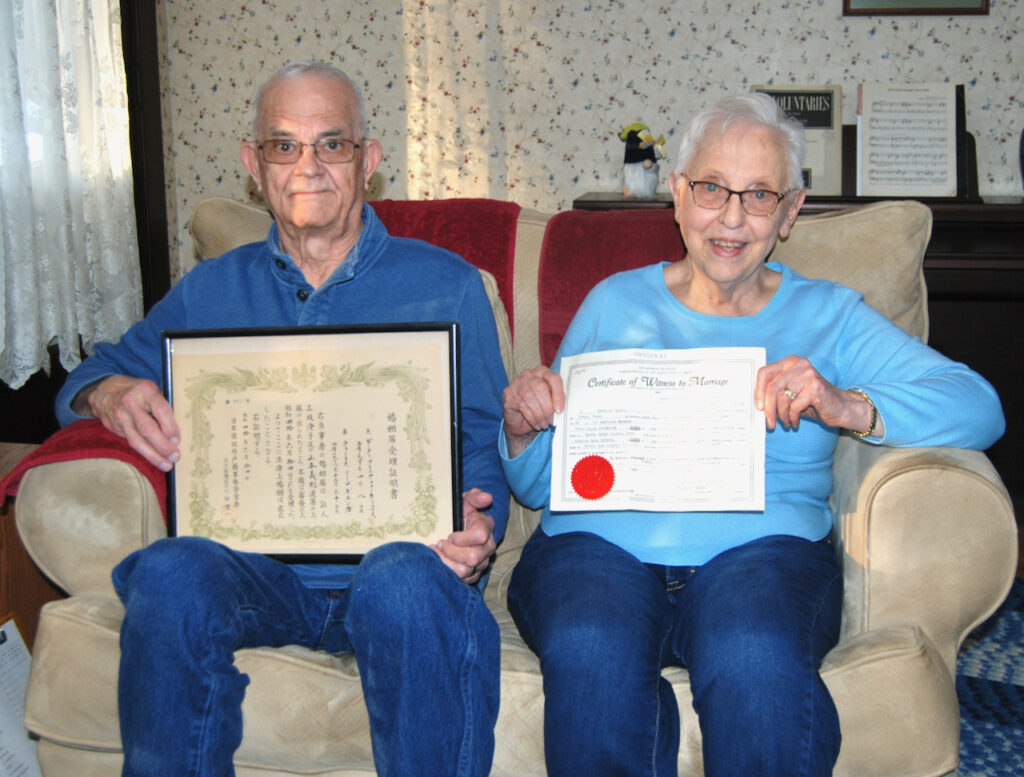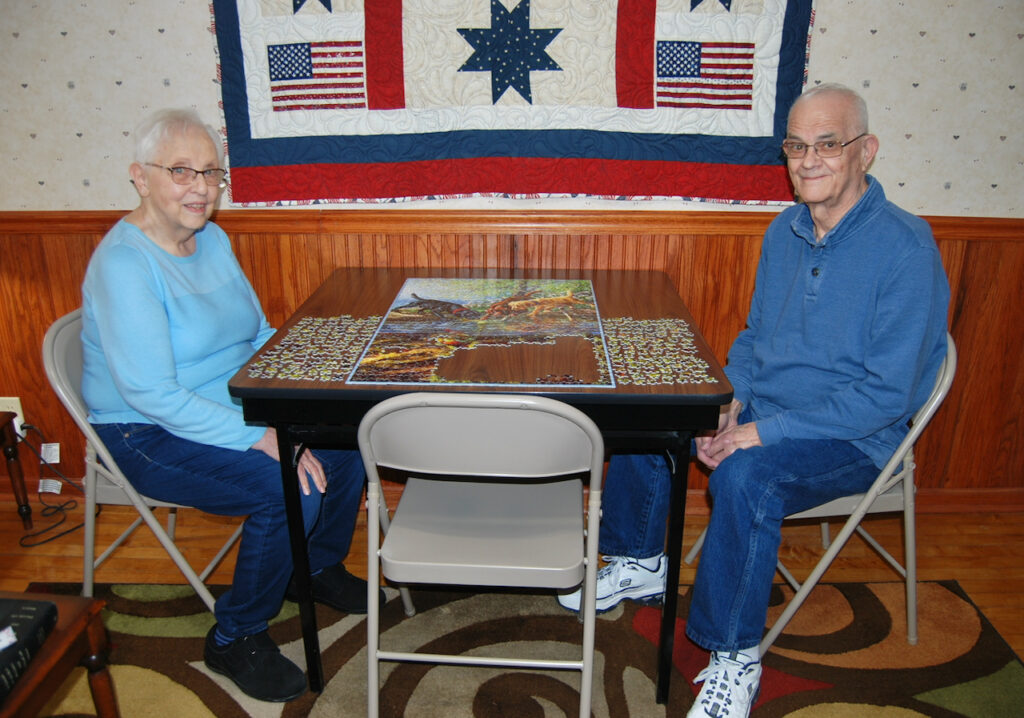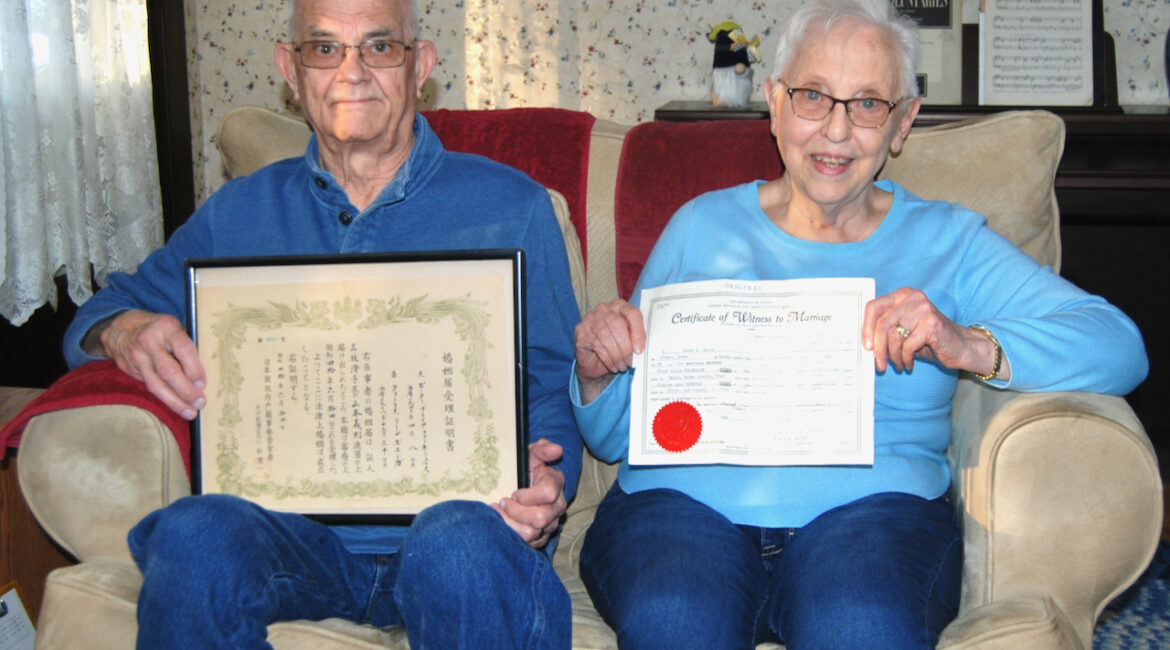By Kim McDarison
While Clarice and Peter “Pete” Fernelius were moving through life as teenagers and in early adulthood on similar paths, the would-be sweethearts did not meet until they were both assigned in the mid-1960s to an Army post in Japan.
After a six-month courtship, they embarked upon what is today a 57-year marriage, and a life journey that ultimately brought them to Fort Atkinson.
Seated together in the living room in their home on Short Street, they reminisced about the years they have spent together. Though they sometimes remembered events differently, and both recalled times that were financial tough, they smiled, as they told their lives’ tale, with a shared sense of humor.
Clarice also shared what she said was an important ingredient to having a long and successful marriage; she summed it up in one word: “care.”
Arriving in California
Clarice said she and Pete are nearly 16 months apart in age, and Pete is the younger of the two.
When Pete was 14, he moved with his family from Utah to California, settling in the San Diego area. He graduated from high school in 1958.
After graduation, he took a civilian job working at a Naval base.
When Clarice was 16, she moved from her childhood home in Illinois, opting to live with an aunt and uncle who lived in California near Oakland. The decision was made, in part, following a set a circumstances that caused some student displacement at Franklin Grove High School. Also, Clarice said, her aunt was a “sweetheart” and she wanted to go. She convinced her parents to let her make the change, she said.
While both teenagers moved to California, they were still nearly 500 miles apart. Clarice attended high school while living with her aunt and uncle, but did not graduate. She instead earned her GED and went to work as a switchboard operator, she said.
In the summer of 1963, Pete was drafted. He was sent to Fort Ord in Monterey where he completed nine weeks of basic training.
Pete was picked for special training in communication intelligence and sent to Fort Gordon in Augusta, Ga. The training lasted for 16 weeks, Clarice said.
In those years, the Army used teletype equipment and he learned about cryptography, Pete said.
Teletype was used to send and receive text-based messages, and cryptography was a process used to encrypt and decrypt messages. It was a means of securing communications, Pete said.
Once his training was completed, Pete was sent to Washington D.C., which was the headquarters for communication specialists. He served at the Pentagon for one week before he was reassigned in March of 1964 to Japan, he said.
In 1963, Clarice said she was operating a PBX, which she described as a type of switchboard, at a children’s hospital in California.
That year, she enlisted in the Army.
She chose training to work with teletype equipment because she thought it would be interesting, she said.
Clarice completed nine weeks of basic training at Fort McClellan in Anniston, Ala., and was next sent to Fort Gordon where she completed the same 16-week course which Pete had earlier taken.
While they arrived at the same installation, she said, they did not meet since Pete had already completed his training. By the time she arrived, Clarice said, it was the spring of 1964.
She next arrived at Fort Knox in Kentucky, and was assigned to a unit that would operate in fields from tanks.
“It was a mistake. The Army did not allow women in tanks. They really wanted a man, so they put me up for reassignment,” she said, adding: “While I was there, I processed deserters and AWALs.”
After a brief stay at Fort Knox, she was reassigned to “the Far East,” she said.
Arriving in Japan
In Japan, Pete said his job was to provide intelligence for his company’s leaders, including the commander, and generals visiting the area.
At the time, he said, the U.S. was engaged in the Vietnam War, but at his base in Japan, his day consisted mainly of receiving information through the teletype equipment and making it easy to read. The information would go into a folder for presentation to the leaders.
He was stationed at Camp Zama, an Army post located in the cities of Zama and Sagamihara, about 40 kilometers, or 25 miles, southwest of Tokyo, he said.
The base is home to Army Military Intelligence and Signal Battalion personnel.
Pete served on the base in Japan for two years, between 1964 and 1966.
Clarice said that while she was awaiting her orders to leave for the Far East, she was returned to an Army base in California near Oakland. She was able to enjoy Thanksgiving and Christmas in 1964 with her aunt and uncle.
After Christmas, she said, she boarded a commercial flight with another woman in the Army and they flew to Tachikawa, a city located in the western portion of the Tokyo Metropolis. There was a U.S. Air Force base there which was used as a staging area. Troops arrived there and were next sent to their various assignments, Clarice said.
Pete said he, too, had arrived at the staging area before arriving at Camp Zama.
Clarice was transported across local roads, which she described as a somewhat harrowing experience, to Camp Zama, arriving in 1964. She, too, stayed until 1966.
A meeting in Japan
While Clarice and Pete worked together in the same communication center, they each worked on different floors, Clarice said.
She recalled that she became a secretary for a warrant officer and she worked in a large office space on the building’s second floor.
Pete worked upstairs, in a vault, she said.
As luck would have it, Clarice said, she did not like her roommate, and as it turned out, another woman who was friends with her roommate was offering to make a switch.
Paired with a new roommate named “Rosie,” Clarice said Rosie invited her to accompany her to a church she attended, and it was there that Rosie introduced Clarice to Pete.
The story brought some pause to Pete. He remembered they met at church, but he didn’t believe he knew a Rosie.
Clarice was confident that Rosie was the one who made the introductions, and said that she often thought it was possible that Rosie might have had a crush on Pete.
Clarice admitted that she took a liking to him right away.
In the weeks that followed, Clarice and Rosie would find reasons to visit Pete. Clarice recalled a visit where they brought him some candy that she had received from her aunt in California.
The three friends attended a church, which was located off base, and often received a ride together from another church-goer.
Eventually, Clarice recalled, Pete called and invited her on a date.
A proposal, a bucket and a mop
Pete and Clarice agreed that they quickly learned they shared similar interests, and they both enjoyed time spent “bumming around,” as Clarice described it, noting that they enjoyed sightseeing in Japan and spending time together.
Six months later, they were married on June 14, 1965.
Describing Pete as a practical man, Clarice said he proposed by handing her “stacks of paper,” which were a request to the base commander for permission to get married.
He’d waited six months, Pete said, which, he noted, “was long enough.”
Clarice said Pete had often said that he didn’t want to get married while the couple was still overseas, but he must have reconsidered.
One of the deciding factors was a potential reassignment for Clarice, they said.
She had earlier been asked to consider attending officer candidate school, which would have required that she return to the U.S. She would also have needed to reenlist.
When she initially told Pete about the offer, Clarice said he suggested that she should look him up if she were ever in San Diego.
Instead, the couple decided to fill out their paperwork, and Clarice did not reenlist. The new plan would allow them to return to the states together, she said.
After receiving permission from the commander, the couple traveled to Tokyo to the Annex of the American Embassy where they were married.
Pete recalled that it cost 80 yen, the equivalent of 24 cents, to have the ceremony performed. The couple received a Japanese marriage license which cost 400 yen, the equivalent of about one dollar, he said.
The document is placed prominently on the living room wall of the couple’s Fort Atkinson home.
They also had a ceremony at their church about a week later attended by friends and church members.
At the time, Pete said, the Army did not pay either of them very much and they lived in poverty.
After they were married, they were allowed to draw a housing allowance.
Pete was “Spec. 4,” which he said was the same pay grade as a corporal, and Clarice was a PFC, private first class, soldier.
“Pete was one rank above me,” Clarice said, “and he made sergeant before we got out.” Before he made the new rank, the couple lived off base.
“We were scraping it,” Pete said.
“When he made sergeant, we got to move on base,” Clarice said.
Clarice remembered that the church friends organized a wedding shower for her and she received as a gift a bucket and a mop.
“Before the shower, we didn’t have a pot to pee in or the window to throw it out of,” Clarice recalled.
“At the shower, I got all kinds of things, and there was cake and flowers. About 30 people attended. They were people affiliated with the military or civilians working for the military,” she said.
Pete extended his tour for six months so they could come home together.
They returned to the states in March of 1966.
California, again
Pete and Clarice returned to California as a married couple traveling on a military flight.
Once they were back in California, Pete had to visit a base in Oakland for one day to get discharged.
The couple moved in with Pete’s family for a short time and Pete found a job with Rohr Aircraft, which, he said, was the same facility he had worked with before being drafted.
In time, Pete’s family moved and gave the house to Pete and Clarice. They lived in California from 1966 to 1973.
During that time, they began a family.
In 1968, they adopted their first child, Kathy, and a few months later, they became pregnant with a second, Lisa, and a few years later, a third child, Mark, was born.
Clarice spent much of the children’s formative years as a stay-at-home mom, she said.
Pete said that, in those years, workers were often laid off from manufacturing jobs. He found himself on the receiving end of those economically-driven decisions several times.
He found work as a civilian, working on the North Island Naval Base.
He worked in teletype like he did while he was in the Army. He was there for about a year. He also returned to school studying math part-time for about three and a half years, taking classes at Grossmont Junior College and then San Diego State University, Clarice said.
Pete said he worked at an egg-packing plant for five years starting in 1968, and then they headed to Illinois.
“Pete was getting laid off because the egg-packing plant closed down,” Clarice said.
A move to the midwest
In 1973, the family decided to move to Illinois.
The move to Illinois was made after a visit to the area to see Clarice’s family.
“I liked the midwest,” Pete said.
So, the young family packed up and made the cross-country move. At the time, the kids ranged in age from that of a toddler to kindergartener.
After a brief stay with family, they moved to a home of their own in Morrison, where they stayed until making a move to Fort Atkinson in 1988.
While they lived in Morrison Pete found work in various factories. He often worked in plants were he could run machines. He worked with a computer-aided lathe system, he said, calling the system “numerically controlled.” He worked with such systems for 15 years, learning how to operate, program, and write programs for the machine.
Between 1973 and 1988, the children grew up and two of the three graduated from high school and began adventures of their own.
When the family moved to Fort Atkinson, members included Pete, Clarice and Mark, who was in his last year of high school.
Mark graduated from Fort Atkinson High School and attended the University of Wisconsin-Whitewater where he studied social studies and psychology, Clarice said.
Today, the couple has six grandchildren, ranging from adult age to 11.
Upon their arrival to Fort Atkinson, the couple leased a home on the city’s south side for a year and moved into the home on Short Street in the fall of 1989.
Life on Short Street
This summer, Pete said, they will have been married for 58 years.
Over the course of that time, Clarice said: “We’ve done everything together.”
A secret to a happy marriage, she said, is learning to “give and take. When you have an argument, you get it settled.”
“I just say, ‘ok, you’re right. Yes, dear,’” Pete said in jest.
“Of course we do fight,” Clarice said, adding: “When I meet people who say they’ve been married for 60 years and never had a fight, I can’t imagine it. They must never spend any time together. We are together 24/7,” she said.
Pete considered the statement. “I do play dartball on Tuesdays,” he said.
Clarice agreed, they do sometimes do things separately.
She noted that Pete retired from work in 2005.
Pete’s last job was at Saelens Manufacturing in Johnson Creek, he said, where they celebrated his retirement with cake.
While in Fort Atkinson, Clarice said she worked at W.D. Hoards and Sons in the office where she entered orders and renewals on a computer.
She also worked at Pick ’n Save in Watertown for 14 years in the cash office and as a front end supervisor. She worked at Sentry in Fort Atkinson and then Festival Foods after the store changed ownership.
Pete worked at Sentry, too, she said. He spent some time there bagging groceries, she said.
As a family, she said, they traveled around together “quite a bit,” and “we took the kids places.”
Pete recalled trips to Niagara Falls and Disney, Washington D.C. and the Hershey Chocolate plant in Pennsylvania.
Today, the couple enjoys spending time at the Fort Atkinson Senior Center. Clarice also volunteers there a few hours each week.
At home, together, the couple tackles jigsaw puzzles.
“It’s good for your brain although we can’t prove it,” Clarice quipped.
They also both enjoy movies on TCM, the Turner Classic Movies network, and they both agreed they like movies with Cary Grant, and most especially “Arsenic and Old Lace,” and “Bringing Up Baby.”
After being married for so long, Pete said he doesn’t really ever get angry with his wife any more.
Clarice said he says what he thinks, and she does, too.
Having a happy marriage, Clarice said: “It isn’t about having a whole lot of money — we’ve never been wealthy — but we’ve always taken care of each other.”
She cited numerous occasions when she was recovering from surgery or illness and Pete was at her side, offering care and comfort.
“He’s always been there and helped take care of me when I needed it. He’s my best friend, definitely,” she said.
Pete, who described himself as a man of few words, listened as his wife described their marriage.
Casting a glance of admiration in her direction, he smiled.

Pete and Clarice Fernelius each hold documents received after they were married. Pete holds a Japanese marriage license which, he said, cost 400 yen, or about one dollar, as part of a wedding ceremony held in 1965 at the Annex of the American Embassy. Clarice holds a Certificate of Witness of Marriage issued by the American Embassy.

Clarice and Pete Fernelius sit at a table in their home where they work together on their most recent jigsaw puzzle. The couple has been married for 57 years.
Kim McDarison photos.
This post has already been read 2587 times!
